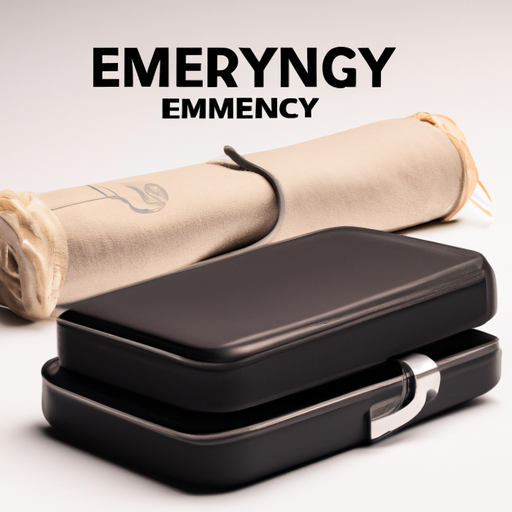As an Amazon Associate I earn from qualifying purchases.
Are you prepared for an emergency? Do you have a plan in place to keep yourself and your loved ones safe in times of crisis? It’s something that we often put off or overlook, but emergency preparedness is crucial for everyone. In this article, we’ll discuss some essential tips to help you be better prepared for any emergency that may arise. So, let’s dive in and get ready for the unexpected!
First and foremost, it is essential to have a basic emergency kit stocked and easily accessible. This kit should include items such as non-perishable food, water, a flashlight, batteries, a first aid kit, and any necessary medications. It’s also a good idea to have copies of important documents, such as identification, insurance papers, and contact information for family members and emergency services. By having these essentials on hand, you can quickly grab your kit and be prepared to take care of yourself and your loved ones in the event of an emergency.
Next, it’s important to have a plan in place. Sit down with your family and discuss what you would do in various emergency scenarios. Determine a safe meeting place outside of your home, should you need to evacuate, and designate an out-of-town contact person who can be reached by everyone in case local communication is down. It’s also helpful to know the emergency procedures and evacuation routes for your area, as well as any potential hazards specific to your location. By having a plan and communicating it to your family, you can ensure that everyone knows what to do in an emergency situation. This article will provide even more tips and information to help you be fully prepared for any unexpected event.
Creating an Emergency Preparedness Plan
Emergencies can happen unexpectedly, leaving you and your loved ones vulnerable. It is essential to have a well-thought-out emergency preparedness plan in place to ensure your safety and the safety of those around you. By identifying potential emergencies, establishing a communication plan, and designating an emergency meeting place, you can be better prepared to face any crisis that may occur.
Identify potential emergencies
The first step in creating an emergency preparedness plan is to identify the potential emergencies that could occur in your area. This could include natural disasters like hurricanes, tornadoes, earthquakes, or floods, as well as man-made disasters such as fires, chemical spills, or terrorist attacks. Research the historical patterns of emergencies in your region and consult local emergency management agencies to gain a comprehensive understanding of the risks you may face.
Establish a communication plan
During an emergency, communication is crucial. Having a communication plan in place ensures that you can stay connected with your loved ones and receive timely information from authorities. Start by creating a list of emergency contact numbers, including those of family members, close friends, and medical professionals. Store these numbers in your phone and keep a printed copy in your emergency supply kit.
Additionally, designate a family member or friend who lives outside your immediate area as a central point of contact. This person can serve as a lifeline in case local communication networks are disrupted. Establish several alternative communication methods, such as text messaging, email, or social media, that can be used when traditional phone lines are down.
Designate an emergency meeting place
In the event of an emergency, it is crucial to have a designated meeting place where you and your family can reunite safely. Choose a location that is easily accessible and away from the potential danger zone. Make sure all family members are aware of the meeting place and how to get there. Remember to take into account the needs of elderly or disabled family members when choosing a meeting place.
Assembling Emergency Supplies
Having the necessary emergency supplies can make a significant difference in your ability to survive and recover from a crisis situation. Adequate water and food storage, a well-stocked first aid kit, and essential tools are essential components of your emergency preparedness plan.
Water and food storage
Water is the most crucial resource for survival and should be stored in sufficient quantities to sustain each person in your household for at least three days. The general rule of thumb is to have one gallon of water per person per day. Be sure to store water in food-grade, airtight containers and rotate your stock regularly to ensure freshness.
Stocking up on non-perishable food items is equally important. Canned goods, dried fruits, granola bars, and other shelf-stable items are excellent choices. Aim to have enough food to sustain your family for at least three days, and don’t forget to include a manual can opener. Consider any specific dietary requirements or allergies when selecting emergency food items.
First aid kit and medications
A well-equipped first aid kit is an essential component of your emergency supplies. It should include bandages, gauze pads, adhesive tape, antiseptic wipes, pain relievers, and any necessary prescription medications. Check your kit regularly to ensure that all items are up to date and replenish any used or expired items.
If you or your family members rely on prescription medications, make sure to have an ample supply on hand. Speak with your healthcare provider about obtaining emergency refills and consider keeping a copy of all prescriptions in your emergency kit.
Flashlights and batteries
During power outages or other emergencies, having a reliable source of light is crucial. Make sure to have an adequate supply of flashlights and batteries stored in a readily accessible location. LED flashlights are an excellent choice as they are energy-efficient and have a longer battery life. Consider investing in rechargeable batteries and a solar-powered charger to minimize waste and ensure a long-lasting light source.

Securing Your Home
In times of emergency, your home should be a safe haven. Taking preemptive measures to secure your property can minimize potential damage and protect your loved ones. Inspecting and maintaining the structural integrity of your home, installing smoke and carbon monoxide detectors, and securing windows and doors are crucial steps to ensure your home’s safety.
Inspect and maintain structural integrity
Regularly inspecting your home for potential hazards and maintaining its structural integrity is essential for the safety of your family. Check for any cracks or loose fittings in the foundation, walls, and ceilings, and repair them promptly. Secure heavy furniture and appliances to prevent them from toppling over during earthquakes or storms. It is also a good idea to have a professional inspect your home’s electrical wiring and gas lines to ensure they are up to code and free from any potential dangers.
Install smoke and carbon monoxide detectors
Smoke and carbon monoxide detectors are vital for early warning in the event of a fire or gas leak. Install smoke detectors on every level of your home, particularly near sleeping areas. Test them regularly and replace the batteries at least twice a year. Carbon monoxide detectors should be placed in areas near potential sources of carbon monoxide, such as gas appliances or fireplaces.
Secure windows and doors
Sturdy windows and doors are crucial in safeguarding your home against intruders and protecting it from the elements. Install secure locks on all windows and doors and consider reinforcing them with additional hardware, such as deadbolts or security bars. In hurricane-prone areas, installing impact-resistant windows and reinforcing garage doors is highly recommended.
Emergency Evacuation Strategies
In some emergency situations, you may be required to evacuate your home. Developing evacuation routes, preparing emergency vehicle kits, and arranging safe shelter options are essential steps in ensuring a smooth and safe evacuation process.
Develop evacuation routes
Identify multiple evacuation routes from your home, taking into consideration different scenarios and potential hazards. Familiarize yourself with these routes and share them with your family members. Plan for alternate routes in case roads are blocked or impassable.
Prepare emergency vehicle kits
In the event of an emergency evacuation, having a well-stocked emergency vehicle kit is essential. Your kit should include essential items such as water, snacks, blankets, a first aid kit, a flashlight, a battery-powered radio, and a toolset. Keep these items in a sturdy container that is easily accessible in your vehicle.
Arrange safe shelter options
If you are unable to remain in your home during an emergency, it is important to identify safe shelter options in advance. Research local evacuation shelters or identify family and friends who live in safer areas where you can seek temporary refuge. Make sure to include any necessary supplies for your family, including medications, pet supplies, and personal hygiene items, when evacuating to a shelter.

Preparing for Power Outages
Power outages are a common occurrence during emergencies. Taking a few simple steps to stock up on non-perishable food, have alternative power sources, and protect sensitive electronics can help you weather a power outage more comfortably.
Stock up on non-perishable food
During a power outage, refrigerated and frozen food may spoil quickly. It is important to stock up on non-perishable food items that can be consumed without cooking or refrigeration. Canned goods, energy bars, nuts, and dried fruits are all excellent options. Make sure to have a manual can opener available and store your emergency food supply in a cool, dry place.
Have alternative power sources
Having alternative power sources can provide you with the necessary energy to power essential devices and equipment during a power outage. Consider investing in a backup generator or portable power bank. Solar-powered chargers are also a great option for charging small electronic devices like phones or tablets.
Protect sensitive electronics
Surges in electrical currents can damage sensitive electronics during power outages. To protect your valuable devices, use surge protectors with built-in voltage regulators. Unplug any unnecessary electronics to avoid potential damage from power surges when the electricity is restored. It is also a good idea to keep a backup of important documents and files on an external hard drive or the cloud.
Emergency Communication Methods
In times of emergency, staying informed and connected is crucial. By keeping a list of emergency phone numbers, utilizing social media platforms, and following radio and emergency broadcast stations, you can stay up to date with the latest information and instructions.
Keep a list of emergency phone numbers
Maintaining a list of emergency phone numbers is essential for quick access to critical services during an emergency. Include numbers for local emergency services, hospitals, poison control, and utility companies. Keep a printed copy of this list in your emergency kit and store important numbers in your phone’s contacts.
Utilize social media platforms
Social media platforms can be valuable tools for receiving and disseminating information during emergencies. Follow local emergency management agencies, government agencies, and reputable news sources on platforms such as Twitter and Facebook. Stay vigilant, however, and verify information before sharing it to avoid spreading misinformation.
Use radio and emergency broadcast
Radio stations and emergency broadcast systems often provide real-time updates and instructions during emergency situations. Invest in a battery-powered or hand-cranked radio and familiarize yourself with local stations that provide emergency broadcasts. Keep spare batteries or a charger for your hand-cranked radio in your emergency kit.
Understanding Emergency Alerts and Warnings
Keeping yourself informed and following official evacuation orders are crucial aspects of emergency preparedness. By staying alert with local news sources, registering for emergency alert systems, and following official evacuation orders, you can navigate emergency situations more effectively.
Stay informed with local news sources
During an emergency, local news sources are an invaluable source of up-to-date information. Regularly monitor local television and radio stations, as well as the websites and social media accounts of reputable news outlets. Subscribe to their emergency alert services if available.
Register for emergency alert systems
Many communities have emergency alert systems in place to notify residents about potential dangers. These systems send notifications via phone calls, text messages, or emails. Register for these services with your local emergency management agency to receive important alerts and warnings directly.
Follow official evacuation orders
Official evacuation orders are issued by local authorities when it is deemed unsafe to remain in a particular area. It is crucial to follow these orders and evacuate immediately to ensure your safety. Be prepared to leave your home at a moment’s notice and have your emergency supplies and important documents readily accessible.
Emergency Preparedness for Pets
When preparing for emergencies, it is important to consider the needs of your furry friends as well. By creating a pet emergency kit, ensuring proper identification, and finding pet-friendly shelters, you can keep your pets safe during times of crisis.
Create a pet emergency kit
Include supplies for your pets in your emergency preparedness kit. This may include food, water, medications, extra leashes and collars, blankets, toys, and any other necessary items. Keep a recent photo of your pet in case they go missing and include copies of vaccination records and identification tags.
Ensure proper identification
Proper identification is crucial in case your pet becomes lost during an emergency. Make sure your pet is microchipped and that the information is up to date. Have identification tags with your contact information securely attached to your pet’s collar. In the event of an evacuation, make sure your pet is leashed or properly contained to prevent them from becoming lost or injured.
Find pet-friendly shelters
If you need to evacuate, it is important to find pet-friendly shelters or accommodations in advance. Many shelters do not allow pets, so research local hotels, boarding facilities, or shelters that accept pets. Have a list of these options readily available so that you can make arrangements quickly when needed.
Emergency Preparedness for Children
Children rely on the guidance and reassurance of their parents or caregivers during emergencies. By teaching children about emergency situations, establishing a family emergency plan, and preparing age-appropriate supplies, you can help alleviate their fears and ensure their safety.
Teach children about emergency situations
Children should be taught about different types of emergencies that may occur and how to respond to them. Use age-appropriate language and explanations to ensure they understand the potential dangers and necessary actions. Conduct practice drills at home so that they are familiar with the procedures and know what to do in different situations.
Establish a family emergency plan
Create a family emergency plan that includes specific procedures and responsibilities for each family member. Assign age-appropriate tasks to children, such as grabbing their emergency kits or helping younger siblings. Establish a communication plan so that family members know how to stay in touch during an emergency and where to meet if separated.
Prepare age-appropriate supplies
Depending on their age, children may have different needs during an emergency. Prepare age-appropriate supplies in their emergency kits, including extra clothing, comfort items, books, and games. Consider any special dietary requirements or medications they may need and ensure these items are included in their kits.
Conclusion
Taking proactive steps to prepare for emergencies is essential for your safety and the well-being of your loved ones. By identifying potential emergencies, assembling emergency supplies, securing your home, developing evacuation strategies, preparing for power outages, utilizing emergency communication methods, understanding emergency alerts and warnings, and considering the needs of pets and children, you can be better equipped to handle any crisis that may arise. Remember to stay calm during emergencies, follow safety guidelines, and regularly review and update your emergency plan to ensure its effectiveness.
As an Amazon Associate I earn from qualifying purchases.










